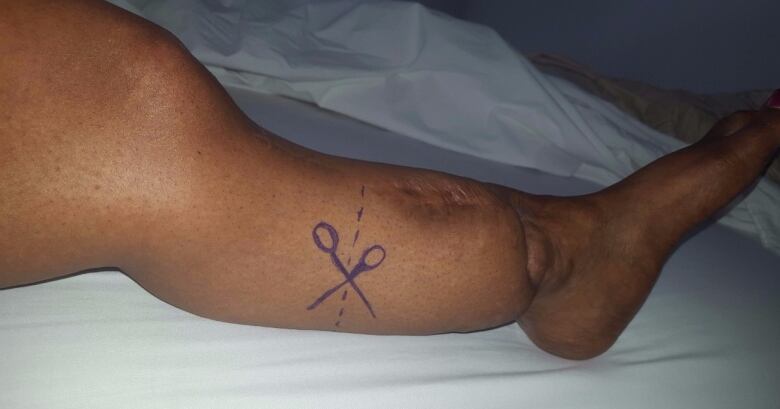Regina woman shocked to discover lack of colour options for prostheses
Rahab Wanjau says her options were 'one very light and one very dark'

On top of the loss of her lower leg to an amputation, a Regina woman is facing the additional struggle of being unable to get a prosthesis that matches her skin tone.
Rahab Wanjau, 30, had surgery last June to have the part of her leg below her knee removed.
None of the colours are my complexion and I was actually very surprised.- RahabWanjau
Wanjau said she did research on the upcoming amputation, but had no idea she would feel so excluded when she went to pick out a prosthetic leg and footat Regina's Wascana Rehabilitation Centre.
The woman, who is originally from Kenya, was given only two colour options to pick from: "one very light and one very dark," she said.
The experience has been a step back in terms of making her feeling included in Regina, she said.
"None of the colours are my complexion and I was actually very surprised."

Wanjau upset by lack of diversity
Wanjauwas born with a deformity of the lower tibia of her left leg. She said she had five surgeries and doctors tried everything, but eventually she was told a leg amputation would be her best option.
According toWanjau, lower leg amputees like her start with an initial prosthetic leg, which helps them learn to walk again. Once they gain motion and mobility, they get a second leg.

Wanjau said she asked her prosthetist for a foot shell in her complexion, or at least close to it, but was told she would have to pay out of pocket to get it, as custom protheses are not covered under theSaskatchewan health plan.
"We are in 2017 ... every year we are getting new iPhones, new makes and models of cars so why not something like a prosthetic leg, which is not a luxury at all? We need them. We don't choose to be amputees," Wanjausaid.
"I'm not looking for a fancy foot shell;I just want a foot shell of my complexion."
Wanjau had to take home a foot shell in a colour far from her own skin tone.
In an attempt to make it blend in more, she bought paint and dye. Unfortunately, she said it turned a colour that didn't resemble her skin at all and it isn't waterproof, so it marks up easily.
Recently, she went to get a new prosthesis and was met with the same problem: a lack of diversity in colouring.
Frustrated, she contacted the manufacturing company, Ottobock, which told her she could order a custom foot shell in her complexion, but would be billed directly. The company only regularly produces two colours for distribution to hospitals and clinics.
"In a country where the level of multicultural diversity is very high, like here in Canada, coming to learn that only two complexions are covered, that didn't go down well with me," saidWanjau."I couldn't understand why."
Dozens of people facing same issue
When Wanjau phoned the health region to inquire, she was told that she was one of at least 100 people to ask the same thing.
Taryn Seel, a certified prosthetist at the WascanaRehabilitation Centre, said when it comes to foot shells that go over top of carbon fibre feet, most companies only supply them intwo or three skin tones.
Having to go through amputation is hard enough already, physically and mentally.Life should be made easier.- RahabWanjau
"I guess because of the volume that manufacturers have to produce, they just have those limited options," said Seel. "I would say greater than 50 per cent of our patients don't utilize a cosmetic cover at all, so the colour and appearance of their prosthesis isn't asimportant to them.
"Then we have patients on the other end of the spectrum who are very concerned about the appearance."
In that case, Seel said they can make a foam cover shaped similarly to the patient's contralateral limb with a cosmetic skin over it. Many more colour options are available when patients take this route, she said.
But Seel saidit depends on many factors whether this option is covered by the Saskatchewan government.
"Having to go through amputation is hard enough already, physically and mentally. Life should be made easier. The health industry should support us," Wanjau said. "We need something done."













_(720p).jpg)


 OFFICIAL HD MUSIC VIDEO.jpg)
.jpg)



























































































